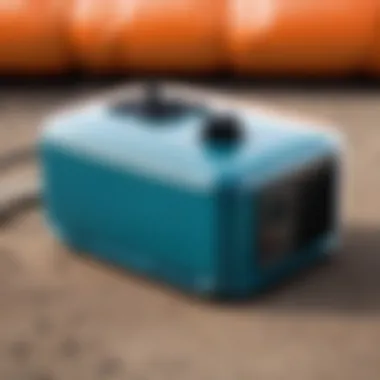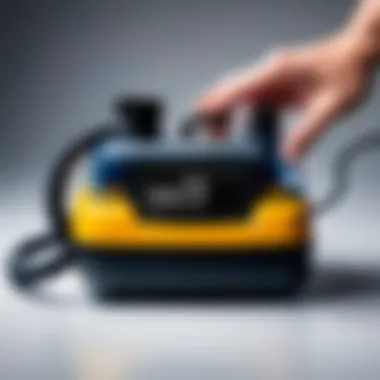Understanding Air Pumps for Inflatable Bounce Houses


Intro
Air pumps are a crucial component when it comes to inflatable bounce houses. Their significance extends beyond mere inflation; they affect performance, safety, and usability. Understanding the technical aspects of these pumps allows users to ensure that their bounce houses remain safe and enjoyable for all participants. The right air pump can enhance the excitement of bounce houses while minimizing risks associated with improper inflation.
In this article, we will explore various air pump types, key specifications, and best practices for selection and maintenance. Additionally, we will delve into comparisons of popular models, practical applications, latest trends, and actionable buying guides. This detailed examination aims to equip readers with essential knowledge to make informed decisions regarding air pumps for inflatable bounce houses.
Technical Specifications
Understanding technical specifications is vital for selecting the appropriate air pump. Several factors contribute to the effectiveness and safety of these devices.
Detailed Product Specs
Air pumps come with specific ratings such as voltage, wattage, and airflow speed. These specifications impact how quickly and effectively they can inflate a bounce house. For example, a typical air pump may be rated for 110 volts with a wattage of 600, providing a high flow rate suitable for large inflatable structures.
Performance Metrics
Performance metrics range from airflow efficiency to inflation time. Some air pumps can inflate a standard bounce house in as little as a few minutes, while others may take longer. The measurement often involves the cubic feet per minute (CFM) value, indicating the volume of air the pump can deliver in a minute. Higher CFM values usually correlate with quicker inflation times, making it an essential factor for busy events.
Compatibility Information
Not all pumps are interchangeable with every bounce house. It’s essential to ensure that the pump’s nozzle fits securely with the inflatable’s valve. Many bounce houses have specific requirements, and this can affect performance. Compatibility is also related to the size of the inflatable; for instance, larger inflatables may need pumps with higher capacity.
Product Comparisons
Conducting product comparisons helps consumers to identify the best pump suited to their needs.
Feature Comparisons
When comparing features, look for aspects such as portability, noise levels, and ease of use. Some models emphasize a quieter operation, which may be essential for events held in residential areas. Others focus on lightweight designs, making them easier to transport.
Price Breakdown
Price varies widely among models. Basic pumps can start around $30, while high-performance versions reach $200 or more. The investment usually correlates with a combination of features, build quality, and capabilities.
User Experience Breakdown
User reviews provide valuable insights into actual performance. The experiences of various users shed light on durability, ease of use, and efficiency. Some pumps may have consistent positive feedback for faster inflation, while others might fall short of expectations regarding usability.
Practical Applications
Identifying practical applications can help users choose the right pump for their specific needs.
Use Cases for Different Users
Families often choose air pumps that balance cost and performance. Events organizers may prefer pumps that are extremely reliable and quick, given the volume of inflatables handled during events. For commercial users, durability and consistent performance are critical factors.
Recommended Configurations
A common recommended configuration includes a powerful electric pump suitable for larger inflatables. Having a backup manual pump is also advisable in case of power outages or emergencies.
Multi-Platform Performances
Some air pumps are designed to work not only with bounce houses but also with other inflatables like pools and water slides. Versatile models that cater to multiple platforms allow for efficient use in diverse settings.
Latest Trends
Staying informed about the latest trends can enhance your purchasing decisions.
Industry Developments
The industry is seeing a push towards more energy-efficient models. Manufacturers strive to create pumps that use less power without sacrificing performance.
Emerging Technologies
Smart technology is beginning to infiltrate the air pump market, with features such as automatic shut-off and mobile app integration for monitoring.
Future Predictions
The future of air pumps likely includes continued enhancements in energy efficiency and convenience, making them more user-friendly and accessible. As inflatable products gain popularity, the demand for high-quality pumps will likely increase alongside.
Buying Guides


An effective buying guide helps simplify the purchasing process.
Recommended Products
Based on performance and user experience, products like the Bounceland Electric Air Pump and the Intex Quick-Fill Electric Air Pump are popular choices.
Purchasing Tips
When purchasing, consider where and how you will use the pump. Check customer reviews and confirm compatibility with your bounce house model before buying.
Warranty and Support Information
Evaluate warranty options and customer support availability. A good warranty can provide peace of mind, ensuring protection against manufacturer defects or performance issues.
Understanding these aspects of air pumps can significantly impact your overall experience with inflatable bounce houses. Armed with this knowledge, you’ll be better positioned to make informed choices that prioritize safety, performance, and enjoyment.
Prelude to Air Pumps for Inflatable Bounce Houses
Inflatable bounce houses have gained immense popularity as a source of entertainment for children and adults alike. These air-filled structures provide a platform for play and exercise while ensuring safety in a controlled environment. However, the effectiveness and safety of these bounce houses heavily depend on the type and quality of the air pump used for inflation.
Air pumps for inflatable bounce houses serve as the backbone of these entertaining structures. They maintain the necessary air pressure to ensure stability and durability during use. Understanding air pumps is crucial for several reasons.
First, the right air pump ensures efficient inflating and deflating processes, saving time and effort. A high-performance air pump can inflate a bounce house in a matter of minutes, enhancing the user experience without unnecessary delays. Conversely, a subpar pump can extend setup times and affect the bounce house's performance.
Second, safety is paramount in inflatable structures. An air pump that fails to deliver the right amount of air can lead to the risk of overinflation or underinflation, both of which can compromise the bounce house's integrity. Familiarity with pump specifications, such as motor power and inflation rate, becomes vital in selecting a suitable product.
Moreover, understanding the features and types of air pumps allows users to make informed choices based on their specific needs. Different models cater to varied requirements, from electric pumps suitable for quick setups to manual options that offer portability.
On a practical note, the knowledge of air pump operation contributes to the longevity of the equipment. Regular maintenance and proper usage can prevent common issues and extend the lifespan of both the air pump and the bounce house.
Understanding the air pump is essential for ensuring safety, efficiency, and durability in inflatable bounce houses.
This article will explore the various aspects of air pumps for inflatable bounce houses, including types, specifications, safety considerations, and maintenance. By the end of this discussion, readers will be better equipped to select the right air pump to enhance their inflatable bounce house experience.
Types of Air Pumps
Understanding the various types of air pumps available for inflatable bounce houses is crucial for users to make informed decisions. Each pump type possesses unique characteristics that can significantly influence the efficiency and performance during setup and use. When selecting an air pump, factors such as speed, user convenience, and power source should be considered. By grasping the distinctions between electric air pumps, manual air pumps, and dual action pumps, consumers can choose the most suitable option for their specific needs.
Electric Air Pumps
Electric air pumps are widely regarded as the most efficient method for inflating bounce houses. These pumps use an electric motor to create air flow, which leads to rapid inflation. Given their ability to fill a bounce house in a matter of minutes, they are ideal for users who prioritize speed and ease. Electric pumps generally require a standard electrical outlet, making them convenient for backyard events or setups where power is accessible.
Main advantages of electric air pumps include:
- Speed: Capable of inflating large structures quickly.
- Effortlessness: Users can simply plug in and switch on, reducing physical labor.
- Consistency: Maintains continuous air flow during use, ensuring the bounce house stays inflated.
However, users should keep in mind some considerations:
- Power Source: Requires access to electricity, which may not be available at all locations.
- Noise: The motor can produce noise during operation, which might be an issue in quiet environments.
Manual Air Pumps
Manual air pumps, as the name suggests, require physical effort from the user to inflate bounce houses. These pumps can be found in various designs such as foot pumps and hand pumps. Although less commonly used for inflatable bounce houses due to their labor-intensive nature, they do provide a solution for areas without electrical outlets.
Benefits of manual air pumps include:
- Portability: Lightweight and easy to transport, making them suitable for outdoor adventures.
- No Power Needed: Operate without electricity, ideal for remote locations or camping.
- Affordability: Generally lower-priced than electric variants.
Yet, these pumps also come with downsides:
- Time-Consuming: Inflating can take much longer compared to electric pumps.
- Physical Effort: Requires significant manual labor, which may be tiring.
Dual Action Pumps
Dual action pumps are a hybrid solution that can function as both manual and electric pumps, offering versatility in use. These pumps can inflate during both the push and pull phases, making them more efficient than standard manual air pumps. Users can alternate between manual operation and connecting to a power source, depending on their situation.
Key features include:
- Flexibility: Users can easily switch between methods based on available power or personal preference.
- Efficient Inflation: Dual-action design speeds up the inflation process compared to traditional manual pumps.
- Compact Design: Most are designed to be portable, making them easy to store and carry.
In summary, understanding the different types of air pumps is essential for anyone considering an inflatable bounce house. Electric pumps offer speed and convenience, manual pumps provide portability and power independence, while dual action pumps combine the best of both worlds. Carefully evaluating these characteristics will lead to better performance and satisfaction during use.
Key Specifications to Consider


When selecting an air pump for inflatable bounce houses, understanding key specifications is crucial. This section will delve into essential elements that affect performance, usability, and safety. Each specification has its relevance, directly impacting how efficiently and safely the pump operates. Choosing a pump involves more than just a hasty decision; it represents an investment in enjoyment and safety for users.
Inflation Rate
The inflation rate of an air pump is a fundamental specification to evaluate. It refers to how quickly the pump can inflate a bounce house. A higher inflation rate means less waiting time before children can start playing. This factor becomes significant, especially in events where time is of the essence. It's advisable to look for pumps that offer a high CFM (Cubic Feet per Minute) rating. This ensures faster inflation, allowing for a more enjoyable experience.
Motor Power
Motor power is another critical specification. Typically measured in watts, the motor’s strength determines how efficiently it can perform the task. A more powerful motor usually translates to faster inflation and extended operating periods without overheating. For bounce houses, it is important to choose a pump with sufficient power to handle frequent use. A pump rated between 600 to 1500 watts usually suits bounce houses well, balancing performance and efficiency. The ability of the motor to operate without significant noise is also a benefit.
Noise Level
Lastly, the noise level of the air pump should not be overlooked. Some inflatable setups occur in residential areas or close to sensitive environments. A quieter pump contributes to a pleasant atmosphere for both operators and users. The sound produced by electric pumps is often rated in decibels (dB). Aim for pumps that operate below 75 dB for a less intrusive experience.
Remember that while a powerful motor is beneficial, consideration of noise levels is equally important for customer satisfaction.
Safety Considerations
Safety is a paramount concern when utilizing air pumps for inflatable bounce houses. Proper knowledge about safety measures can drastically reduce accidents and equipment damage. Understanding the risks associated with air pumps is crucial for ensuring a safe environment for users, particularly children. Below, we delve into several key areas that warrant attention.
Overinflation Risks
One of the primary risks associated with inflatable bounce houses is the possibility of overinflation. When a bounce house is inflated beyond its recommended capacity, it can lead to structural failure. This failure may result in damage to the inflatables and can pose serious safety hazards for users.
Overinflation can happen for a few reasons:
- Incorrect Air Pump Settings: Certain electric pumps allow users to set desired pressure levels. Not adhering to these settings can result in excessive inflation.
- Temperature Changes: As temperatures rise, the air inside the bounce house expands, increasing the risk of overinflation.
- Continuous Air Supply: Some bounce houses rely on a constant air supply. If not monitored, the continuous influx of air may exceed the safe limits of the material.
To mitigate these risks, users should always follow manufacturer guidelines regarding inflation. Regularly checking the inflatable's pressure during use can also ensure it remains within safe limits.
Electrical Safety
Given that most air pumps are electric, electrical safety cannot be overlooked. Mishandling or negligence can result in electrical shocks or fires. Understanding basic electrical safety is essential for anyone operating an air pump.
Consider the following best practices to ensure electrical safety:
- Use GFCI Outlets: General Use Ground Fault Circuit Interrupter (GFCI) outlets provide an added layer of protection, as they cut off power in case of a ground fault.
- Inspect Cords Regularly: Regularly check power cords for frays or cracks. Damaged cords can lead to short circuits or electrical shocks.
- Avoid Water Exposure: Ensure the air pump and its electrical components remain dry. Water can greatly increase the risk of electrical hazards.
By adhering to electrical safety practices, users can significantly reduce even critical incidents.
Stability and Weight Distribution
The stability of an inflatable bounce house depends significantly on the proper weight distribution and anchoring. An uneven distribution of weight can lead to tipping or collapsing, which could injure users.
To maintain stability, consider the following:
- Proper Anchoring: Ensure that the bounce house is properly anchored to the ground using stakes. This secures the inflatable and enhances stability during use.
- Weight Limits: Abiding by the manufacturer's weight limit for the bounce house is crucial. Overloading can compromise the structure and increase the likelihood of accidents.
- Regular Monitoring: During use, continuously monitor the bounce house for any signs of instability or distress. If any problems arise, address them immediately and remove users if necessary.
Employing these strategies will enhance safety and ensure a fun experience for all participants in the bounce house.
Key Takeaway: Proper attention to safety considerations can prevent accidents and ensure that everyone enjoys a safe environment while using inflatable bounce houses.
Operating an Air Pump
Operating an air pump correctly is essential for anyone using an inflatable bounce house. The annual growth of inflatable attractions makes it necessary to understand the entire inflation and deflation process to ensure safety and efficiency. This section intends to delve into the significant steps involved in the operation of an air pump. Knowing the proper methods can help prolong the life of the inflatable unit itself and enhance user experience.
Setup Procedure
Setting up the air pump requires some careful attention. First, choose a level, dry surface to place the inflatable bounce house. This ensures stability during use. Once the desired spot is selected, carefully unpack the air pump and check its components for any defects. Any visible damage could affect performance or safety.
Next, position the pump near the bounce house’s inflation port. Avoid running long extension cords to prevent tripping hazards. Ensure that the air pump's power cord is in a safe place, keeping it away from water and not tangling with other wires.
Also, familiarize yourself with the pump's settings. Many models have different modes or speed options, useful for tailoring air pressure to specific bounce house requirements. Following the manufacturer's instructions at this stage is vital to avoid potential operational issues later on.
Inflating the Bounce House
The inflation phase is crucial. Engage the power to the air pump and observe the setup for smooth functioning. It is normal for the bounce house to rise as air fills it. Keep monitoring the inlet for any unusual noises or resistance, which could mean a blockage in the system.
As the inflatable takes shape, periodically check the tautness of the material. A bounce house should not feel overly stiff. If it does, this could indicate overinflation, which can lead to damages. Most inflatable bounce houses are engineered to allow some flexing; thus, achieving a balance in air pressure is important.
Tip: Regularly refer back to the user manual of your bounce house model for specific inflation guidelines.
Deflation Techniques


Once the fun session is over, the deflation process can begin. Turn off the air pump and remove the plug from the bounce house's inflation port. Start by opening any release valves present to help expedite airflow. It’s valuable to gently press on the bounce house sides as the air escapes to prevent the material from folding incorrectly, which can cause creases or tears.
Deflation can take some time. However, ensuring a slow release of air is better for the integrity of the material. After most air has released, fold the inflatable carefully and store it per the manufacturer’s instructions to avoid moisture and pests. Proper storage can extend the life of the bounce house considerably.
Utilizing these methods when operating an air pump can enhance overall safety and performance. Understanding the steps involved removes a layer of complexity and makes the experience far more enjoyable.
Maintenance of Air Pumps
Maintenance of air pumps is crucial in ensuring optimal performance and extending the lifespan of these devices. Neglecting maintenance can lead to decreased efficiency, increased noise levels, or even malfunction. By dedicating time to regular maintenance, users can greatly enhance the safety and reliability of their inflatable bounce houses.
Routine Cleaning
Cleaning your air pump routinely is essential for removing debris and preventing damage. Dust and dirt can accumulate in the air intake and motor, causing overheating or reduced airflow. Here are some steps to follow:
- Disconnect the power before cleaning. This is vital for safety.
- Use a soft cloth to wipe down the exterior, removing dirt and grime.
- Check air intakes and vents, ensuring they are free of obstructions.
- Vacuum the interior, if possible, to remove dust without disassembling too much.
Routine cleaning not only improves airflow but also minimizes wear and tear on critical components.
Inspecting Power Cords and Connections
Regular inspection of power cords and connections is another essential step in maintenance. Faulty cords can lead to inadequate power supply or even electrical hazards.
- Look for frayed or damaged cords. Replace them immediately to prevent accidents.
- Ensure all connections are secure and free from corrosion.
- Test the pump periodically to confirm it operates smoothly after inspections.
By ensuring that power supply components are in good condition, one can avoid unexpected pump failures.
Storage Practices
Proper storage of air pumps is critical, especially after their use. Factors such as humidity, temperature, and mechanical stress can negatively impact the equipment.
- Store in a dry, cool place to prevent moisture damage.
- Avoid stacking heavy items on top of the pump, which could cause physical damage.
- Keep it in its original packaging or a dedicated storage bag to protect it from dust and dirt.
Effective storage minimizes the risk of damage and keeps the air pump ready for the next use.
Remember: Regular maintenance is not just about checking if the pump works; it's about ensuring safety and performance over time.
Comparison of Popular Air Pump Models
Choosing the right air pump for inflatable bounce houses is critical for ensuring smooth operation and optimal performance. Each model on the market has unique specifications and features that can significantly impact usability and efficiency. By assessing popular models, users can make more informed decisions based on their specific needs. The right air pump can enhance the bounce house experience, making it more enjoyable for everyone involved. It can also save time and reduce the likelihood of equipment failure during use.
Model A: Specifications and Features
Model A is designed with efficiency in mind. This electric air pump boasts a high inflation rate of 600 liters per minute, allowing for quick setup. Its motor power is rated at 600 watts, which ensures it can handle larger inflatable structures with ease. One notable feature is its compact design, which makes it easy to transport. Additionally, Model A operates with a noise level below 60 decibels, making it suitable for residential areas where noise restrictions may apply.
Key Features:
- High inflation rate of 600 liters per minute
- 600-watt motor power
- Compact and lightweight design
- Noise level below 60 decibels
- Automatic shutoff to prevent overinflation
Model B: Specifications and Features
Model B presents a slightly different approach by prioritizing multi-functionality. This dual-action pump can inflate and deflate, giving users flexibility when setting up and storing bounce houses. With an inflation rate of 500 liters per minute, it’s efficient but not as quick as Model A. The motor power is also lower, rated at 450 watts. However, it is built with durability in mind, equipped with reinforced housing to withstand occasional drops or rough handling. This can be particularly beneficial for users who frequently transport their equipment.
Key Features:
- Dual-action functionality
- Inflation rate of 500 liters per minute
- 450-watt motor power
- Durable reinforced housing
- Lightweight and easy to carry
Model C: Specifications and Features
Model C distinguishes itself with its innovative SMART technology, which monitors the air pressure inside the bounce house while it is being inflated. The inflation rate is comparable to Model A, at 550 liters per minute. The motor power stands at a robust 700 watts, providing extra force for larger or heavier inflatables. It features an adjustable nozzle that can fit various types of inflatable connections, enhancing its usability. Additionally, this model emphasizes safety with an overheat protection feature, ensuring that the pump doesn't exceed safe operating temperatures.
Key Features:
- SMART technology for pressure monitoring
- Inflation rate of 550 liters per minute
- 700-watt motor power
- Adjustable nozzle for various inflatables
- Overheat protection feature
Finale
In this article, we explored various aspects of air pumps specifically designed for inflatable bounce houses. Understanding the significance of the right air pump is crucial for maximizing both performance and safety. A suitable air pump not only inflates the bounce house efficiently but also prevents potential hazards, such as overinflation or equipment failure.
Importance of Choosing the Right Air Pump
Selecting the correct air pump involves consideration of several elements. First, the type of pump chosen, whether electric or manual, can greatly impact the ease of setup and time required for inflation. Higher-quality pumps typically offer better performance and longevity.
Benefits of Proper Operation and Maintenance
Regular maintenance of air pumps is key to ensuring long-lasting performance. Routine cleaning and inspection of cords can prevent accidents or malfunctions. Furthermore, understanding how to inflate and deflate correctly is crucial in maintaining the bounce house’s structural integrity.
Final Considerations
This article has synthesized important details regarding the operation, selection, and care of air pumps for inflatable bounce houses. For consumers, tech-savvy users, and anyone involved in operating these recreational products, comprehending these factors will yield better experiences and safer enjoyment. Taking the time to choose the right air pump, understanding its specifications, and committing to maintenance practices significantly enhances safety and performance.







